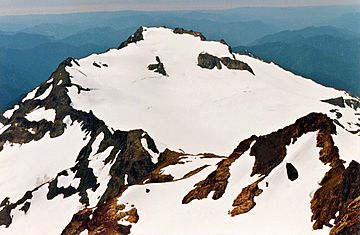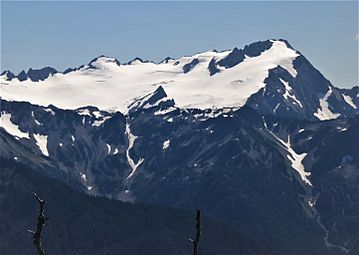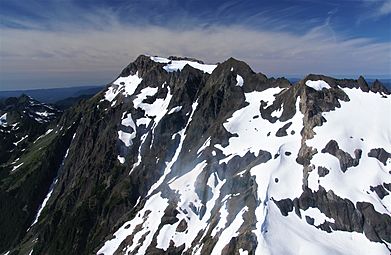Mount Tom (Washington) facts for kids
Quick facts for kids Mount Tom |
|
|---|---|

Mount Tom seen from Mount Olympus
|
|
| Highest point | |
| Elevation | 7,076 ft (2,157 m) |
| Prominence | 716 ft (218 m) |
| Isolation | 2.27 mi (3.65 km) |
| Parent peak | Mount Olympus (7,980 ft) |
| Geography | |
| Location | Olympic National Park Jefferson County, Washington, US |
| Parent range | Olympic Mountains |
| Topo map | USGS Mount Tom |
| Geology | |
| Age of rock | Eocene |
| Climbing | |
| First ascent | 1914 Edmond S. Meany, Boy Scouts |
| Easiest route | Glacier + class 3 scrambling |
Mount Tom is a tall mountain peak found in Olympic National Park in Jefferson County, Washington state. It stands about 7,076 feet (2,157 meters) high. Its closest big neighbor is Mount Olympus, which is a bit taller and lies to the east.
Even though Mount Tom isn't the highest mountain, it gets a lot of snow in winter. This snow helps create the huge White Glacier on its northeast side. This glacier is special because it's the westernmost glacier in the main part of the United States. Also, Mount Tom's summit is the westernmost peak that is over 7,000 feet tall. Water from the mountain flows into streams that lead to the Hoh River.
Contents
The Story Behind Mount Tom's Name
This mountain was first named Mount Reid in 1890 by a group called the Seattle Press Expedition. They named it after Whitelaw Reid, who was a newspaper editor.
Mount Tom's current name has two different stories about how it got its name. One story says it was named after Thomas M. Hammond, Jr. He was a surveyor who worked in the western part of the Olympic Peninsula between 1895 and 1904.
The second story is more exciting for young adventurers! It says the mountain was named after a 13-year-old boy scout named Thomas Martin. He was part of the first group to climb the mountain in 1914. This climbing trip was led by Edmond S. Meany, who was the head of Scouting in Seattle at the time. Mr. Meany promised the boy scouts that the first one to reach the top would have the mountain named after them. Young Tom Martin was the fastest and won! Tom Martin later became an important person in Washington state, even running for governor in 1952.
Weather and Climate Around Mount Tom
Mount Tom is in a "marine west coast" climate zone, which means it's near the ocean. Most of the weather systems come from the Pacific Ocean and move towards the Olympic Mountains. When these weather systems hit the tall Olympic peaks, they are forced to rise. This causes them to drop a lot of rain or snow, especially in winter.
So, the Olympic Mountains get a lot of rain and snow. During winter, it's often cloudy. But in the summer, high pressure systems over the Pacific Ocean usually bring clear skies. The best time to visit or climb Mount Tom is from July to September, when the weather is usually the nicest.
How Mount Tom Was Formed
The Olympic Mountains are made up of different kinds of rocks, mostly sandstone and basalt. These rocks were formed a very long time ago, during the Eocene period. Over millions of years, the mountains were shaped by things like erosion and glaciers. During the Pleistocene era, huge sheets of ice (glaciers) moved across the land many times. As they advanced and then melted away, they carved out the valleys and peaks we see today, including Mount Tom.
Gallery
Images for kids






